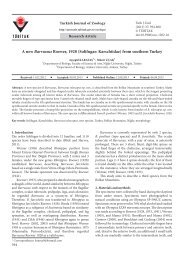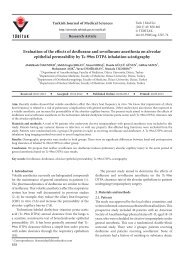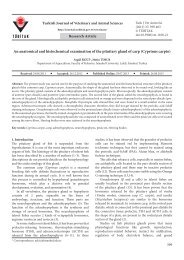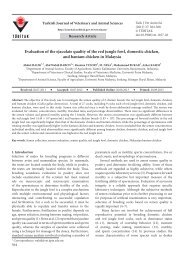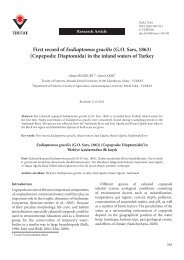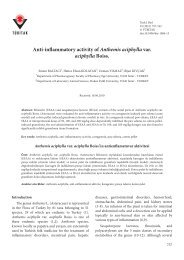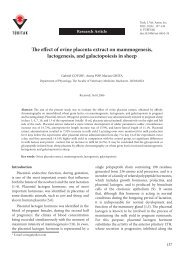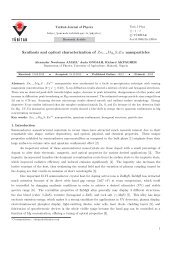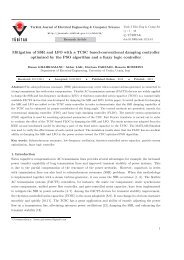Preliminary study on Acropora - Scientific Journals - Tübitak
Preliminary study on Acropora - Scientific Journals - Tübitak
Preliminary study on Acropora - Scientific Journals - Tübitak
You also want an ePaper? Increase the reach of your titles
YUMPU automatically turns print PDFs into web optimized ePapers that Google loves.
Figure 2. <strong>Acropora</strong> valida: a) live col<strong>on</strong>y; b) part of col<strong>on</strong>y; c)<br />
porti<strong>on</strong> of branch; d) SEM micrograph showing micrograph<br />
showing a few radial corallites; e) SEM micrograph showing<br />
coenosteum <strong>on</strong> a radial corallite; f) SEM micrograph showing<br />
top view of an axial corallite; g) SEM micrograph showing<br />
coenosteum between radial corallites.<br />
both with a round opening; development of septal cycles<br />
varies depending <strong>on</strong> the positi<strong>on</strong> of the radial corallites<br />
<strong>on</strong> the branch. In those located from the branch base to<br />
near its tip 2 complete cycles are present, but these are<br />
incomplete and poorly developed in the radial corallites<br />
located at the branch tips; primary septa up to 1/2R, except<br />
for the directives that are well developed; sec<strong>on</strong>dary septa,<br />
if present, a low ridge maximum 1/3R.<br />
Coenosteum: Costate to broken-costate <strong>on</strong> radial<br />
corallites proper (Figure 3e); sometimes densely arranged<br />
lines of laterally flattened spinules <strong>on</strong> radial corallites;<br />
coenosteum between radial corallites reticulate with<br />
dispersed, laterally flattened, and slightly elaborated<br />
spinules (Figure 3g).<br />
Color: Brown to cream-brown or greenish brown.<br />
<strong>Acropora</strong> horrida (Dana, 1846); Figures 4a–4g<br />
Material examined: Iran, Farur Island: 26°17′44.1″N,<br />
54°32′22.4″E; depth 6 m; 28 October 2009; MMTT Cnid.<br />
1348. Larak Island: 26°52′45.8″N, 56°20′26.8″E; depth 6<br />
m; 14 October 2008; ZUTC Cnid. 1305.<br />
RAHMANI and RAHIMIAN / Turk J Zool<br />
Figure 3. <strong>Acropora</strong> aspera: a) porti<strong>on</strong> of col<strong>on</strong>y; b) porti<strong>on</strong> of<br />
branch; c) SEM micrograph showing terminal part of branch; d)<br />
SEM micrograph from lateral view of radial corallites, note the<br />
gutter-shaped appearances formed by the outer walls; e) SEM<br />
micrograph showing coenosteum <strong>on</strong> a radial corallite; f) top view<br />
of axial corallite showing extent of primary and sec<strong>on</strong>dary septa; g)<br />
SEM micrograph showing coenosteum between radial corallites.<br />
Descripti<strong>on</strong>: Branching pattern: Arborescent; slightly<br />
tapering branches (Figures 4a and 4b); branch diameters:<br />
7.9–11.3 mm, 7.2–10.5 mm, 6.0–9.4 mm; branch length up<br />
to 26.1 mm; growth indeterminate.<br />
Axial corallites: C<strong>on</strong>spicuous; outer diameter 2.0–2.6<br />
mm; calice diameter 1.2–1.6 mm; primary septa present,<br />
maximum 3/4R; sometimes dentate; sec<strong>on</strong>dary septa<br />
absent (Figure 4f).<br />
Radial corallites: Extremely fragile; with different sizes;<br />
ragged surface (Figure 4c); profile length 2.0–4.5 mm;<br />
round opening; septa poorly developed, particularly the<br />
inner septa; primary septa up to 1/3R; outer directive<br />
septum more developed than the inner directive;<br />
sec<strong>on</strong>dary septa absent.<br />
Coenosteum: Broken-costate to reticulate <strong>on</strong> radial<br />
corallites proper (Figure 4d); reticulate between radial<br />
corallites; simple, laterally flattened spinules scattered <strong>on</strong><br />
and between radials (Figures 4e and 4g).<br />
Color: Brown.<br />
311



